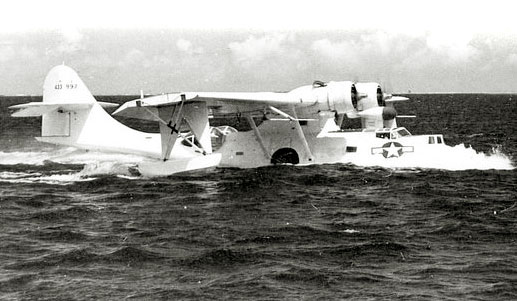|
This pick-up proved to be one of the first made by the Army
Air Corps crews, this particular crew arrived in New Guinea only
three days earlier, and it was their first rescue mission. In six
sweeps round the enemy coastline, this Catalina had been shot at by
the Japanese. Despite shortage of fuel, the captain - John Denison -
had made a last search southwards and in the final run sighted
the dinghy. On land near the dinghy, it was reported that about
sixty Japanese soldiers had been cut off from supplies and had
resorted to cannibalism.
The record of the 2nd Emergency Rescue Squadron gives this as their first
operational mission. Lt. Denison had searched the reported area for
seven hours before sighting the dinghy two miles away. He
picked up the survivors at 10:00hr after Bill Amos and his crew had
been in the dinghy for thirty hours.
In this year of writing --- 1986 --- Bill Amos resides in
Albuquerque, happily growing peaches and melons. Another ex-AAF
pilot --- John Crawford, in New Jersey, tells me he has located two
of the Catalina rescue crew.
Two days after the rescue of Bill Amos, No 2 ER Squadron was
ordered to evacuate wounded men from within enemy-held territory in
Dutch New Guinea, near lake Rombebai. For this operation, Captain
Gerard F. Wientjes touched |
|
down on the
lake and taxied within 100yd of the shore.
[Read Mission Report]
A dinghy was launched and
ten Allied soldiers were picked up together with a Japanese
prisoner. That morning the Allied soldiers had overpowered a gaurd
and had then been attacked by about fifty of the enemy. Fifteen of
the enemy were accounted for, but seven of the Allies had suffered
wounds from Japanese sabres, knives, and bayonets.
After attention by a medical officer, the soldiers were taken
by dinghy to the Catalina. The amphibian was taxied into deep water,
seaweed was removed from the landing gear, heavy equipment was
jettisoned together with 500 gallons of fuel and after three
attempts at take-off, they were airborne. This was in sight of the
enemy on the shore a thousand yards away, but no shots were
exchanged. The survivors were taken to Owi Island before transfer to
the 92nd General Hospital. They stated: "We prayed for daylight
and a PBY, and if heaven looks anything like a PBY we are going to
change our ways."
The following month, Captain Wientjes
evacuated eleven men from Warsaw Bay, Biak Island. One was wounded,
the other ten had typhus and were taken to Owi Island.
[Previous
page... | Next page...] |
